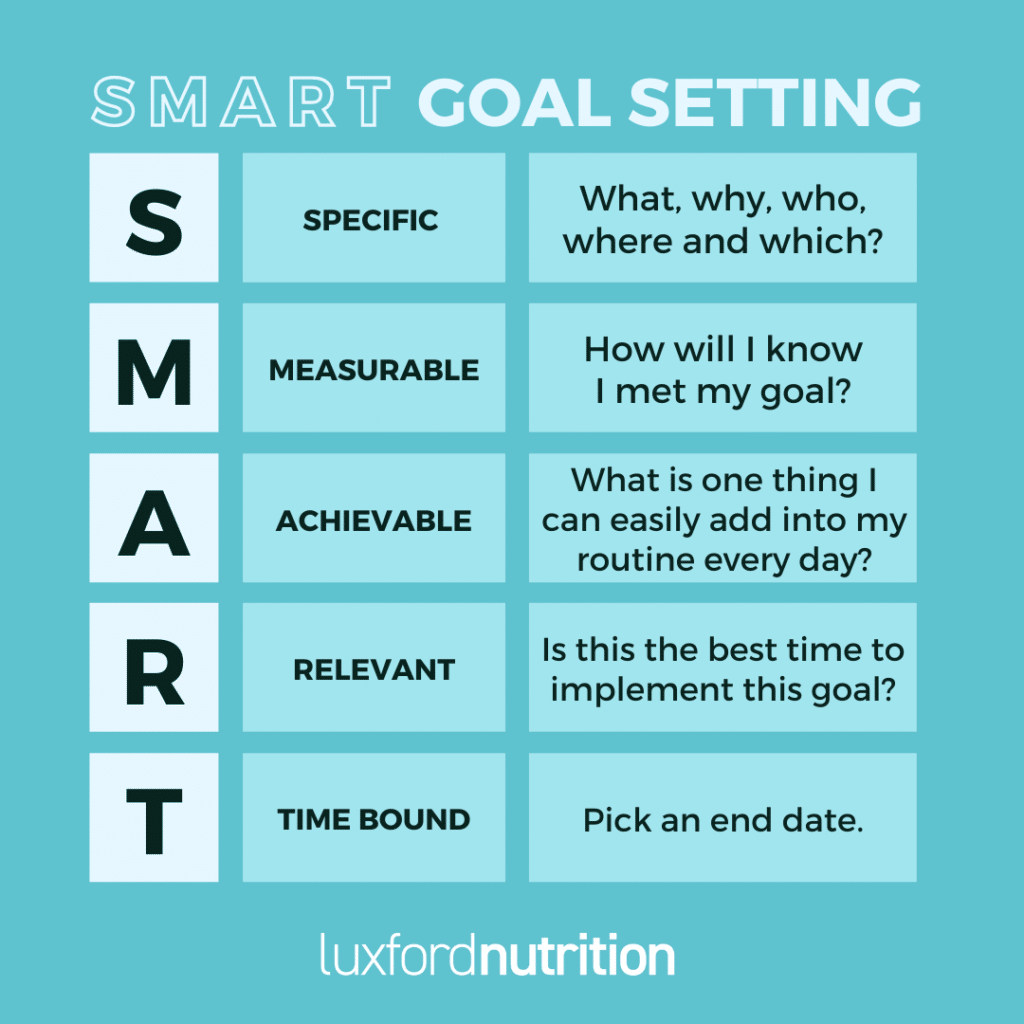
Keeping Yourself on Track with Your New Year’s Resolutions
You made your New Year’s resolutions… Now let’s talk about how to actually keep your New Year’s resolutions and goals.
I once read that most New Year’s resolutions are abandoned by January 19. Could this be true? Are our intentions that easily torpedoed? While reviewing data, I found a study from 1989 (1) that documented 77% of people maintained resolutions for one week while only 19% maintained their goals for two years. Recent blogs highlight surveys that indicate similar results for specific goals such as weight loss or smoking cessation. These reports were not surprising to me.
77% of people maintained resolutions for one week while only 19% maintained their goals for two years.
From my 10 plus years of nutrition practice, I am aware that most people seek my help because they are unable to successfully implement change on their own. It doesn’t matter how many educational materials are provided to them or the litany of information online. In fact, my graduate thesis (2) supported these claims. It noted that individuals who received education and support from a dietitian were better able to implement a diet change compared to individuals who received a handout or read about the diet online. It makes sense that this data could be extrapolated to all forms of intervention. Professional help significantly improves behavior change. With that said, many of you are struggling with goals because you do not have the skills with which to implement those goals. Let’s set the foundation for goal setting in 2022, so you can actually keep your New Year’s resolutions.

1. Set Goals the S.M.A.R.T. Way
Start with a SMART goal. SMART is an acronym that stands for Specific, Measurable, Achievable, Relevant and Time Bound. Let’s spend some time discussing each of these components.
-
SPECIFIC:
Your goal should have a clear target and the goal should answer the five W’s of what, why, who, where and which.
-
-
- What is my end goal?
- Why am I choosing this goal?
- Who is involved in this goal?
- Where will I implement this goal?
- Which items are involved in implementing and maintaining this goal?
-
-
MEASURABLE:
Your goal should be quantifiable or trackable. Monitoring your progress will help motivate you to continue and to recognize any challenges in your plan to implement the goal. Ask the question, “how will I know I met my goal?” For example, I want to add one apple to my weekly intake for the year. This provides a specific food for a specific duration with a measurable goal of one apple per week.
-
ACHIEVABLE:
Your goal should be realistic with your food preferences, health status and life demands. Be realistic. It is better to set basic goals and achieve them than set lofty goals that cannot be implemented. Basic goals can be layered over the year to have a significant impact overall. For example, working out with a trainer several days per week when you don’t own a gym membership and have a strict budget is not an achievable goal. If exercise is your goal for 2022, start with an activity that you can easily integrate into your routine such as walking, push ups or sit ups.
-
RELEVANT:
Your goal should have significance to your life and health status. You can test the relevance of your goal by asking the following questions.
- Is this the best time to implement this goal?
- Will this goal help me?
-
TIME BOUND:
Pick an end date. It can be a short-term goal (1 week or 1 month) or a long-term goal (3 months, 6 months, 12 months). Short term goals are preferable because they can be extended or layered to build complex goals.

2. Adjust Your Environment to Build Better Habits
Fine tune your environment to make sure your desired intervention has the necessary support to succeed.
This may look like choosing a goal that is linked to a previous goal or a behavior that is well embedded in your daily routine. For example, if you love tea but don’t drink enough water then choose teas that are herbal or decaf to help reduce the diuretic effect of tea and improve your hydration level.
This might be a simple change to your routine. Instead of storing your fruits and vegetables in the drawer of your refrigerator, place them at eye level to help increase your fruit and vegetable consumption.
Another modification to your environment might include your relationships. Let your friends and family know about your goals. This way they will understand when you choose to abstain from alcohol or when you choose to exercise in the morning instead of feasting on a hearty breakfast.
And finally, change is hard. Consider hiring a professional like a dietitian to help you implement your goals. Dietitians and other medical providers can help you create realistic and effective plans. Dietitians are the masters in changing diet and lifestyle to improve health. Professionals play an important role in providing accountability and encouragement. They can also help you decrease obstacles and adjust the goal as necessary to improve goal implementation. If you’d like to discuss how this can work for you, please reach out via my contact page.

3. Strategies and Tools to Help You Keep Your New Year’s Resolutions
If you want to make a change and need a helping hand, here are a few of my favorite strategies for goal setting:
- Post Its: Post it notes can serve as a friendly reminder of what you need to accomplish and what you have accomplished.
- Journal: If you want to keep your goals personal, write them down in a journal and make note of your progress. You can even keep a journal in your notes section on your phone.
- Pedometer: This is a useful tool to help you build awareness regarding your activity level. You can even track your heart rate with some monitoring devices.
- Oura Ring: If you want to invest in a sleep and activity tracker, this might be the right gadget. It even guides the user through meditations and keeps track of menstrual cycles. This ring provides information based on the user’s physiological data. Learn more here.
- Goal Buddy: This free service will help you create SMART goals. You can track your progress on this platform with like-minded buddies to help you stay on track. Learn more here.
- LifeTick: This service helps you delve deeper into goal setting and is a good tool for those who are feeling overwhelmed by this process. Visit LifeTick at this link.
- Habit List: This service will help you build a habit so that your goal becomes routine without much forethought. Learn more about Habit List here.

4. Treat Yourself!
Finally, the most important aspect of goal implementation is celebrating the small wins and not sweating the challenging days. This will help you remain focused. When you develop SMART goals and align your environment with those goals, you can confidently remind yourself that you can do this! You can do this for today, tomorrow and beyond. Everyone loves a good reward. Choose to reward yourself at the end of the week or month when you have implemented your goals. This will provide joy and a sense of accomplishment.
With these tools handy, you will find statistics are actually in your favor. In 2002, John C. Norcross (3) noted that individuals who choose to make resolutions are more likely to succeed than those who choose not to participate in New Year’s resolutions.
…Individuals who choose to make resolutions are more likely to succeed than those who choose not to participate in New Year’s resolutions.
“Resolvers reported higher rates of success than nonresolvers; at 6 months, 46% of the resolvers were continuously successful compared to 4% of the nonresolvers.”(3)
Don’t mind the statistics that most people don’t maintain their resolutions. Choose a resolution, follow these tips, and realize that your initial goal will most likely evolve over time to yield positive outcomes.
Cited Sources:
- J Subst Abuse. 1988-1989;1(2):127-34. doi: 10.1016/s0899-3289(88)80016-6.
- Otol Neurotol. 2013 Oct;34(8):1438-43. doi: 10.1097/MAO.0b013e3182942261.
- April 2002 Journal of Clinical Psychology 58(4):397-405 DOI:10.1002/jclp.1151

